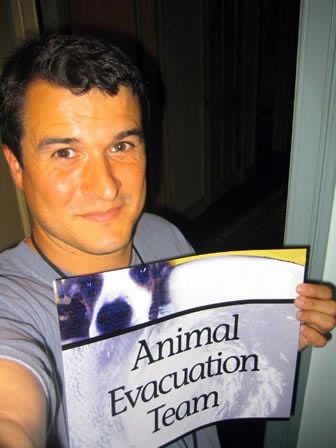Mexico's Katrina?




My guess is animals come last in Mexico and no US animal rescue groups seem to be stepping up.
TABASCO, MEXICO
300,000 TRAPPED AFTER TABASCO FLOODS
http://www.gulfnews.com/world/Mexico/10164571.html
11/2/07: More than 300,000 people are believed to be trapped in their homes
after severe flooding hit the southern Mexican state of Tabasco. A huge
rescue operation has begun after torrential rains caused widespread flooding
in the region.
One person has been confirmed dead so far but more than 1m are thought to
have been affected by the floods. Dramatic rooftop helicopter rescues are
being seen on television. Mexican President Felipe Calderon called it "one
of the worst natural disasters in the history of the country."
MEXICO FLOODING AFFECTS 700,000
http://news.bbc.co.uk/2/hi/americas/7072554.stm
Thousands remain stranded in the worst flooding in 50 years The authorities
in Mexico say as many as 700,000 people have been affected by heavy rains
and severe flooding in the south-eastern state of Tabasco.
The governor has called on anyone who owns a seafaring vessel to help free
the 300,000 people believed to be trapped in their homes. Rescuers have also
been using helicopters to try to reach people stranded on rooftops.
Labels: animal rescue, mexico animals, mexico floods




2 Comments:
Eric:
Corolla here. (Humane Animal Trapper in New Orleans after Hurricane Katrina)
Are you heading there? If so, get in touch with me. I'm looking at heading in for possibly human and animal rescue if I can determine logistics.
Corolla
cfinsouthbay@gmail.com
Villahermosa, Tabasco, Mexico
I just returned from Mexico.
When Richard Crook obtained a rental vehicle, he took me out to Gaviota Sur to view the water line and devastation. The waterlines were dropping drastically in Villahermosa, Tabasco. The state of Tabasco was 80% flooded but the government has permitted people back into their homes immediately and installed numerous large pumps to remove the remaining water. Water levels have dropped approximately 2 feet per day in the city! Only in Gaviotas Sur were a few homes still flooded but food and water were supplied to those animals. It may have looked like New Orleans for about 3 days, but after that, the people returned, pumps were brought in and very few animals were trapped. In the rural areas however, the water was receding much slower than in the city, but still there was access.
Most of the issues now are issues typical for this area and not disaster related. If resources such as hay and veterinary medicine become available, the animals would greatly benefit. The main population overall affected is the cattle. We did not have provisions for the livestock such as chicken, turkeys, cows, horses and pigs. Food for all the animals such as dogs and cats are not found in abundance in the cities or rural area. People feed human food to the animals. Karen O'Toole was able to secure a helicopter flight and I accompanied her for an aerial view. The city appeared dry overall, but the rural areas were still 50 to 65% flooded. When details were finally settled a few days later, teams went out to feed, assess, and obtain further information. We did not see many areas that were flooded still. A few areas of Gaviotas Sur had water approximately 1' to 3' deep, but it was small pocketed areas.
Overall, I've never seen water pumped out or receding from an area as quickly as in Villahermosa.
We did not see mass abandonment of animals as we had seen in New Orleans. With the government's proactive stance in getting pumps running and allowing people immediate access, we saw very few stranded animals or people after that initial few days.
Problems we saw were common health problems and different standards of care as is typical of developing countries. The only differences were that 1) the grazing lands for the cattles are devastated and will result in significant long-term effects and that 2) many of the livestock will exhibit health issues associated with standing in stagnant water for lengthy periods of times such as hoof rot.
After two to three weeks, there were no real disaster-related issues anymore in terms of urgent rescue.
The local government and local rescues are taking over the food operations. Water operations was overall completed in Tabasco. Most of what I saw in terms of what we could provide for aid was reminiscent of Peace Corps. Really, not disaster related anymore after the first 3 days.
Corolla Fleeger
cfinsouthbay@gmail.com
Post a Comment
<< Home